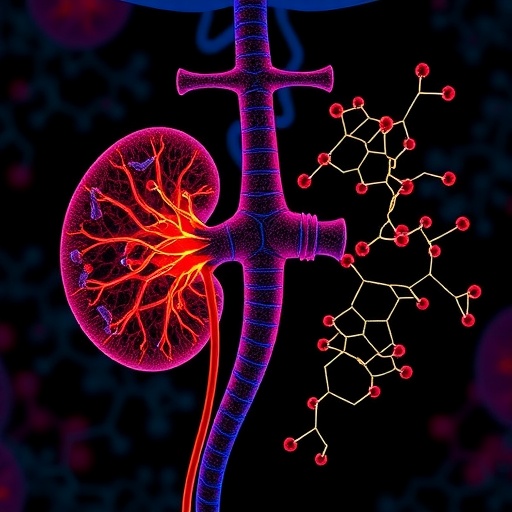In a groundbreaking new study that could revolutionize the management of diabetic kidney disease (DKD), researchers have unveiled compelling evidence that the composition of the urinary complement proteome is intricately linked with the progression of this devastating condition. Published in Nature Communications, the study by Md Dom, Moon, Satake, and colleagues meticulously characterizes the urinary proteomic landscape, shedding light on how the complement system—a critical component of innate immunity—may serve as a valuable biomarker and potential therapeutic target for DKD.
Diabetic kidney disease remains one of the leading causes of end-stage renal failure worldwide, affecting millions of individuals with diabetes. Despite advances in glycemic control and blood pressure management, the progression of DKD in many patients remains inexorably relentless, highlighting an urgent need for novel biomarkers that can predict disease trajectory and inform personalized interventions. The complement system, with its sophisticated cascade of protein interactions that modulate inflammation and immunity, has long been implicated in various renal pathologies. Yet, its precise role and diagnostic utility in DKD had remained elusive until now.
Employing state-of-the-art proteomic technologies, the research team undertook a comprehensive analysis of urine samples from individuals at different stages of diabetic kidney disease. By leveraging mass spectrometry and advanced bioinformatic algorithms, the investigators generated an exhaustive urinary proteome profile, focusing specifically on components of the complement system. Their data revealed striking alterations in the abundance of key complement proteins correlating robustly with both clinical parameters such as albuminuria and estimated glomerular filtration rate (eGFR), as well as the progression rate of kidney dysfunction.
One of the most compelling findings was the elevated presence of complement activation fragments, including those derived from C3 and C5 components, in urine samples from patients with advanced DKD. These fragments are known mediators of inflammation and tissue damage, suggesting that complement activation within the renal microenvironment contributes directly to the pathological remodeling and fibrosis observed in diabetic kidneys. The researchers postulate that urinary complement proteins do not merely reflect a passive byproduct of kidney injury but actively partake in disease progression, making them a dual-purpose marker for monitoring and intervention.
Delving deeper into the molecular mechanisms, the study revealed that the dysregulated complement proteome associates with tubular epithelial cell injury and heightened inflammatory signaling cascades, which are hallmarks of diabetic nephropathy. This nexus between complement activation and tubular dysfunction proposes a mechanistic pathway whereby persistent immune activation exacerbates renal lesions. It also opens intriguing avenues for therapeutic targeting—complement inhibitors designed to modulate this proteolytic cascade might arrest or even reverse disease progression if administered at appropriate disease stages.
Importantly, the researchers’ longitudinal cohort study demonstrates that shifts in the urinary complement proteome precede overt clinical manifestations of kidney function decline, implying considerable prognostic value. This temporal relationship, validated across multiple patient groups and independent cohorts, underscores the feasibility of urinary complement profiling as a non-invasive, early detection platform. Such diagnostic precision could transform current clinical protocols that rely heavily on less sensitive markers like serum creatinine and spot urine albumin measurements.
The technological advancements enabling these insights are equally remarkable. Mass spectrometry-based proteomics, capable of identifying thousands of proteins with exquisite sensitivity, was meticulously optimized to quantify low-abundance complement proteins in complex urine matrices. The integration of machine learning models further refined the discrimination between stable and progressive DKD phenotypes, paving the way for algorithm-driven risk stratification. This marriage of high-resolution proteomics and computational analytics exemplifies the future of precision nephrology, where molecular signatures guide tailored therapeutic regimens.
This study also raises intriguing questions about the systemic versus local origin of the urinary complement proteins identified. While some complement components might originate from plasma filtration, others likely arise from intrarenal synthesis by resident cells in response to hyperglycemia-induced stress. Deciphering these spatial and temporal dynamics will be crucial in developing targeted strategies that either block complement synthesis or activation specifically within the kidney, minimizing off-target effects.
Moreover, the research highlights the intersection of metabolic and immune pathways in diabetic kidney disease. The complement system, traditionally viewed through an immunological lens, emerges here as a mediator bridging metabolic dysregulation and chronic inflammation. This paradigm shift broadens our understanding of DKD pathogenesis and encourages a multidisciplinary approach integrating immunology, metabolism, and nephrology in future investigations.
The clinical implications of these findings are profound. Currently, treatment options for DKD are limited and largely reactive, often failing to halt progression to renal failure. The identification of urinary complement proteins as biomarkers offers a proactive strategy to identify high-risk patients who might benefit most from emerging complement-targeted therapies. Furthermore, monitoring complement proteome dynamics could provide early readouts of treatment efficacy, enabling adaptive clinical decision-making.
While the study lays a robust foundation, several avenues warrant further exploration. The heterogeneity of diabetic kidney disease across populations necessitates validation studies encompassing diverse ethnic and demographic groups. Additionally, integrating urinary complement profiling with other omics data—including genomics, transcriptomics, and metabolomics—may yield comprehensive molecular fingerprints of disease, advancing beyond single-pathway analyses.
In conclusion, the elucidation of a urinary complement proteome signature tightly linked to diabetic kidney disease progression heralds a new era in nephrological research and clinical practice. By revealing the complement system as both a biomarker reservoir and a potential pathogenic driver, this study charts a promising course toward precision diagnostics and targeted therapeutics. As global diabetes prevalence escalates, innovations such as these are urgently needed to alleviate the burgeoning burden of diabetic kidney disease and improve patient outcomes worldwide.
Subject of Research: The relationship between the urinary complement proteome and the progression of diabetic kidney disease.
Article Title: Urinary Complement proteome strongly linked to diabetic kidney disease progression.
Article References:
Md Dom, Z.I., Moon, S., Satake, E. et al. Urinary Complement proteome strongly linked to diabetic kidney disease progression. Nat Commun 16, 7291 (2025). https://doi.org/10.1038/s41467-025-62101-5
Image Credits: AI Generated




